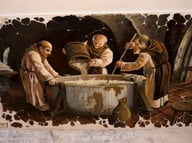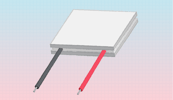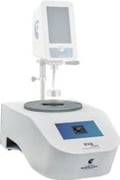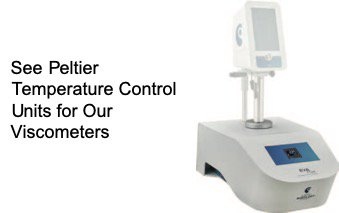Peltier temperature control is becoming more common in viscosity testing, but traditional water baths are still the norm for many companies. Should you switch Peltier-based temperature control for you critical samples?
I am going to explore the pros and cons of the Peltier plate vs. the water bath for controlling the temperature of your product.
Water Baths
The water bath creates controlled temperature environments. Temperature control of samples is critical in many viscosity testing applications. For these viscosity measurements, the sample, the sample container and the measuring spindles are immersed the bath. The test is started when the sample elements  reach temperature equilibrium with the water.
reach temperature equilibrium with the water.
There are two main categories of water baths. One operates from ambient temperature to just under 100 degrees Centigrade. These units usually include temperature controlled heaters. The second operates from temperatures to as low as minus 25 degrees Centigrade to 100 degrees Centigrade. These units have both heater and refrigerant systems. To get to temperatures below ambient, glycol-type mixtures of water are used as the controlled media.
Until the ascent of Peltier plates, traditional water baths were the option of choice for temperature controlled viscosity tests. Peltier system developments led to simpler solutions and provided comparable accuracy and temperature stability.
Peltier Plates
This sandwich of semiconductors between two layers of thermo-conductive ceramic is known as a Peltier Plate. When subjected to a DC voltage a current flows and one side will produce heat and the other side will cool.
If the direction of the current is reversed the cool side will radiate heat. The original warm side will become cool.
 Peltier plates can be of various sizes. They can be as small as 2 square millimeters (less than 1 square inch) and be larger than 70 square millimeters (approximately 3 square inches). The temperature range for Peltier devices is from -40℃ to 200℃. With this temperature range a Peltier plate system can eliminate the need for a refrigerant cooling system at temperature below ambient.
Peltier plates can be of various sizes. They can be as small as 2 square millimeters (less than 1 square inch) and be larger than 70 square millimeters (approximately 3 square inches). The temperature range for Peltier devices is from -40℃ to 200℃. With this temperature range a Peltier plate system can eliminate the need for a refrigerant cooling system at temperature below ambient.

What is the Peltier Effect?
The Peltier thermoelectric effect produces heating and cooling at the junction of two dissimilar semiconductor materials as a reaction to the application of a DC voltage between them.
Heat is absorbed or emitted between the junctions of two dissimilar conductors when a current is passed. In the typical Peltier element these conductors are of P-Type and N-Type semiconductor material. To produce a Peltier thermoelectric element, conductors are sandwiched between two ceramic plates of high thermal conductivity. Connectors are attached to each of the semiconductor materials.
To control the heating or cooling, a DC voltage is applied across the connectors. Heat is generated or absorbed depending on the polarity of the DC voltage.
Pros
When compared to water baths and refrigerated circulating baths, Peltier systems have some significant advantages.
Peltier elements have no moving parts, which simplifies maintenance. These plates can produce lower than ambient temperatures without the need for separate cooling systems. Refrigerants are no longer a requirement.
Because of their small physical size, temperature control can be incorporated into individual equipment packages.
Peltier plates permit temperature control to tight tolerances. They also offer little hysteresis, which increases reliability.
Cons
Peltier plates can be affected by thermal shock, which can happen with the recycling of the temperature from high to low. This is most often a problem when the cycle rate is very high and the temperature differential is large.
Peltier plate design development for specific applications can mostly overcome this problem. Long MTF (mean time to failure) can be expected with adequate design.
Why choose the Peltier plate or the water bath?
Peltier plates are finding a growing use in laboratory equipment. This is particularly evident with the applications requiring temperatures below ambient. In particular, Lamy Rheology has introduced Peltier self-contained temperature controllers for rotational viscosity tests. (Temperature range)
In Summary
The utilization of the Peltier effect is growing in laboratory instruments. It’s now finding a place as in-box temperature control devices in rotational viscometers. Peltier plates can effect a wide temperature range. At temperatures below ambient, Peltier-based instruments do not require refrigeration systems, greatly simplifying the device.
Please share this review with associates who have sample control issues.
P.S. Want to get more articles like this one? Subscribe at the top of the page.


